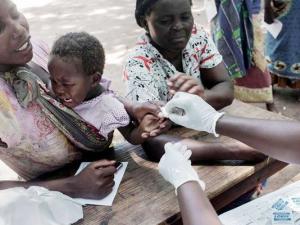
Malaria remains a threat despite gains
Uganda is among six countries that accounted for more than half of all malaria cases last year, according to the World Malaria Report 2019.
Nigeria led with 25 per cent of all the cases, DR Congo (12 per cent), Uganda (five per cent) while Cote d’Ivoire, Mozambique and Niger recorded four per cent each.
Tanzania and Rwanda each recorded three per cent while Kenya recorded the least cases at two per cent.
Globally, there were about 155 million estimated malaria cases in the 11 high burden, high impact countries in 2018, compared with 177 million in 2010. The number of deaths reduced from about 400,000 in 2010 to about 260,000 in 2018.
MALARIA CONTROL
In 2018, Uganda became the first country in the region to launch a targeted malaria control response. This was a global campaign to reduce cases and deaths caused by malaria by at least 40 per cent by 2020 and subsequently by 75 per cent by 2025.
In Uganda, despite the national prevalence declining, the disease remains the number one cause of illness and death. It was one of the 21 countries with nearly 85 per cent of malaria deaths globally last year.
According to a statement released by the Health Ministry in Uganda, more than one million people were infected with malaria in Uganda in June and July attributing the rise partly to climate change.
“This time of year is peak malaria season, but prolonged June rains seem to have created an even more fertile breeding environment for the mosquitoes that transmit the infectious disease,” says a statement by the ministry.
Almost 85 per cent of all deaths in 2018 occurred in 20 countries in Africa were accounted for by Nigeria at 24 per cent followed by the DR Congo at 11 per cent, Tanzania, five per cent, and Niger, Mozambique and Angola at four per cent each.
In East Africa, Tanzania led in the number of deaths at 21,500 followed by Uganda at 13,000, Rwanda was third with 3,200 deaths while Kenya recorded 2,000 deaths in 2018, this a reduction as compared to 2017 figures.
Despite the reduction in the number of malaria cases and deaths, the report shows that, globally, progress has stalled in high burden countries and that the milestones are, therefore, unlikely to be achieved.
However, between 2014 and 2018, the rate of change slowed dramatically, from 60 in 2013 to 57 in 2014 and remaining at similar levels through to 2018.
In Africa, case incidence levels declined from 294 in 2010 to 229 in 2018, representing a 22 per cent reduction in incidence, although the rate of change also appeared to slow from 2014.
The World Health Organisation highlighted in the report that underlying intensity of malaria transmission, socio-demographic and epidemiologic risk factors, poor access to care are some of the factors that have contributed to the stalling and raising the number of infections.
CONSTRAINTS
Funding constraints have also been highlighted as a contributing factor.
For East Africa, the war against the disease has yielded a bag of mixed fortunes. Where it has succeeded, the bed net has always been the uncelebrated hero. All the countries rely heavily on insecticide-treated nets.
Their use has increased with Uganda with the highest distribution of long-lasting insecticidal nets at 85 per cent (11 million nets) followed by Kenya at 72 per cent (2.6 million), Rwanda in third position at 68 per cent (or 974,800 nets).
In Tanzania, the government did not distribute any net in 2018.
Dr Amos Kahwa of the National Institute for Medical Research earlier said bed net coverage in Tanzania still faces challenges, and “more research is needed, especially on how to better increase the coverage without relying on free distribution.”
There are people, says Dr Kahwa, who use the free nets for fishing, even though the Minister for Health, Community Development, Gender, Elderly and Children, Ms Ummy Mwalimu, believes the government has to keep budgeting for the service.
Dr Damian Rutazaana, a malaria epidemiologist with the National Malaria Control Programme, says malaria cases in Uganda normally peak twice a year, after the rainy seasons of June-July and November-December.
TRANSMISSION
He added that transmission in the country is hyper-holoendemic, meaning some areas record high transmission rates whereas others have low infections attributing the sharp fall to government interventions, including scaling up of treatment services and distribution of insecticide-treated mosquito nets.
Kenya has, on the other hand, made strides in reducing the death rate among children and women through prevention and treatment. The Ministry of Health has so far distributed 30 million bed nets to areas with a high prevalence. It has also pumped Ksh200 million into indoor spraying of homes to prevent the risk of infection.
In September, Kenya became the third country after Malawi and Ghana to start the routine vaccination of infants against malaria using the world’s first vaccine to combat a disease that kills 800 children globally every day.
The vaccine, RTS, S, targets the deadliest and most common form of the malaria parasite in Africa, where children under five account for two-thirds of all global deaths from the disease.
The vaccine will be given in phases across malaria-endemic parts of western Kenya near Lake Victoria.
REGIONAL TOLL
In Uganda, despite the national prevalence declining, the disease remains the number one cause of illness and death. It was one of the 21 countries with nearly 85 per cent of malaria deaths globally last year.
In East Africa, Tanzania led in the number of deaths at 21,500 followed by Uganda at 13,000, Rwanda was third with 3,200 deaths while Kenya recorded 2,000 deaths in 2018, this being a reduction as compared with the 2017 figures.
